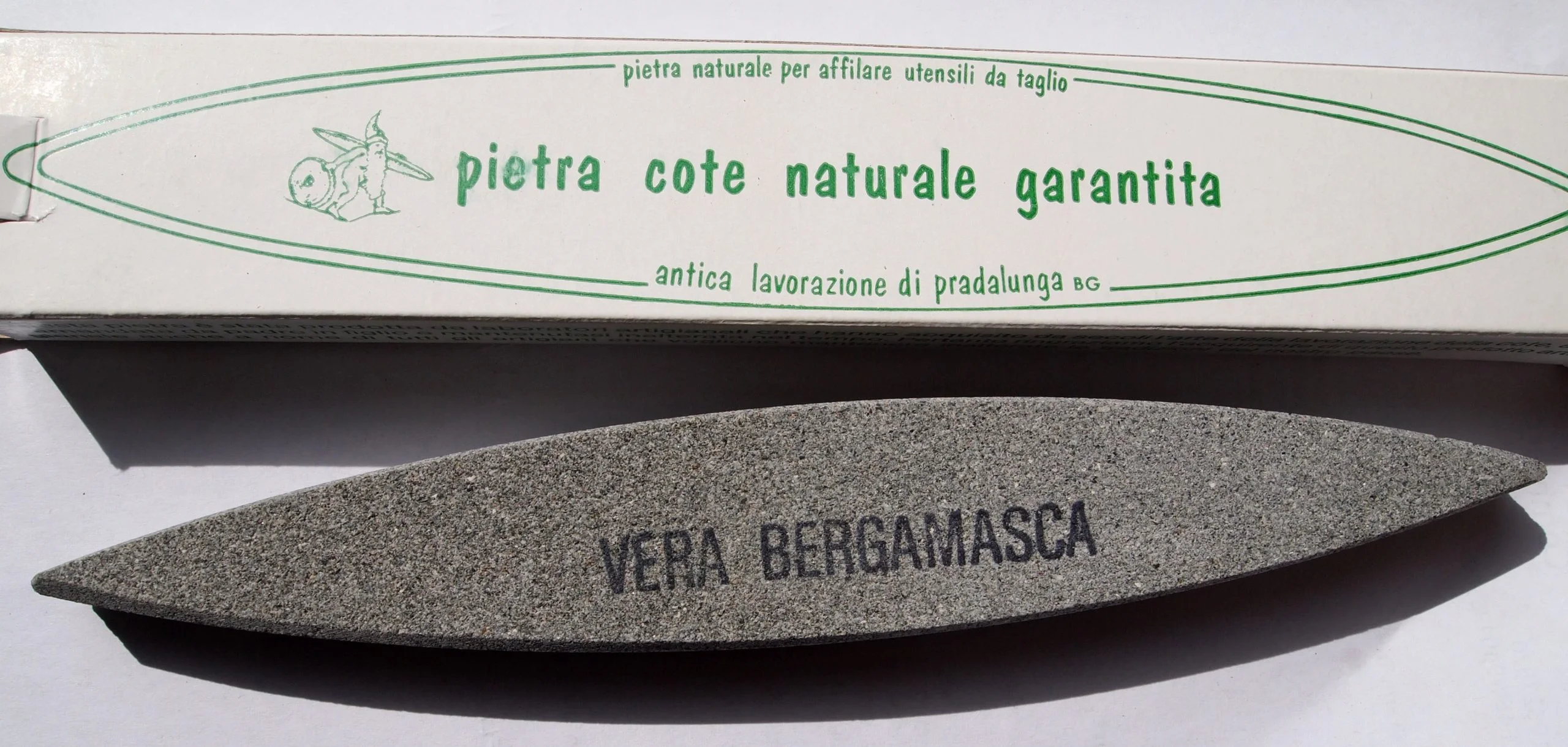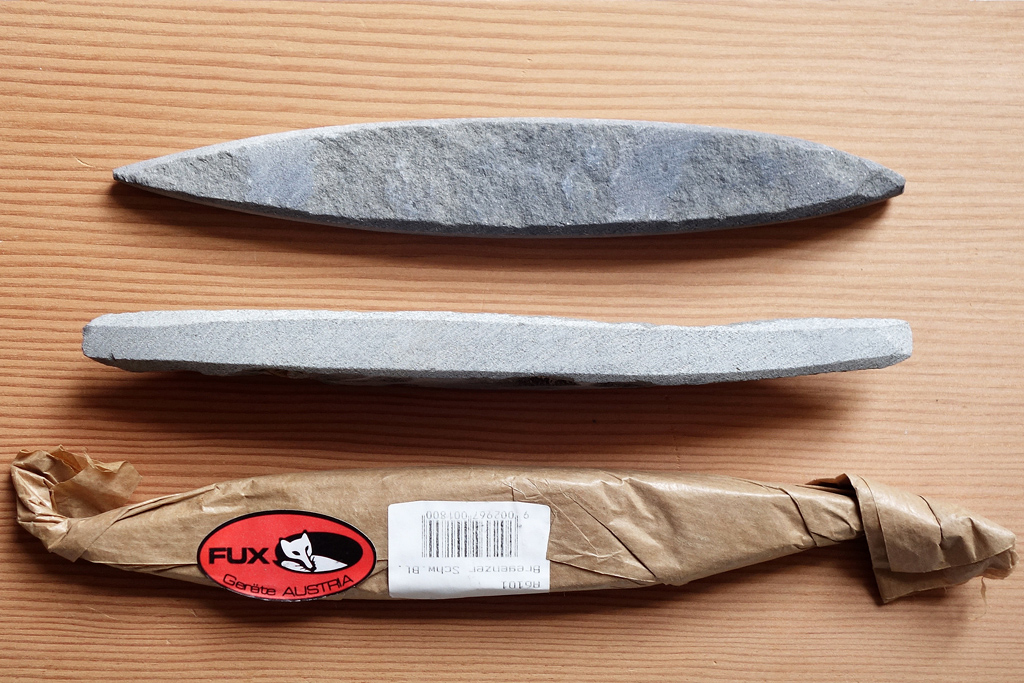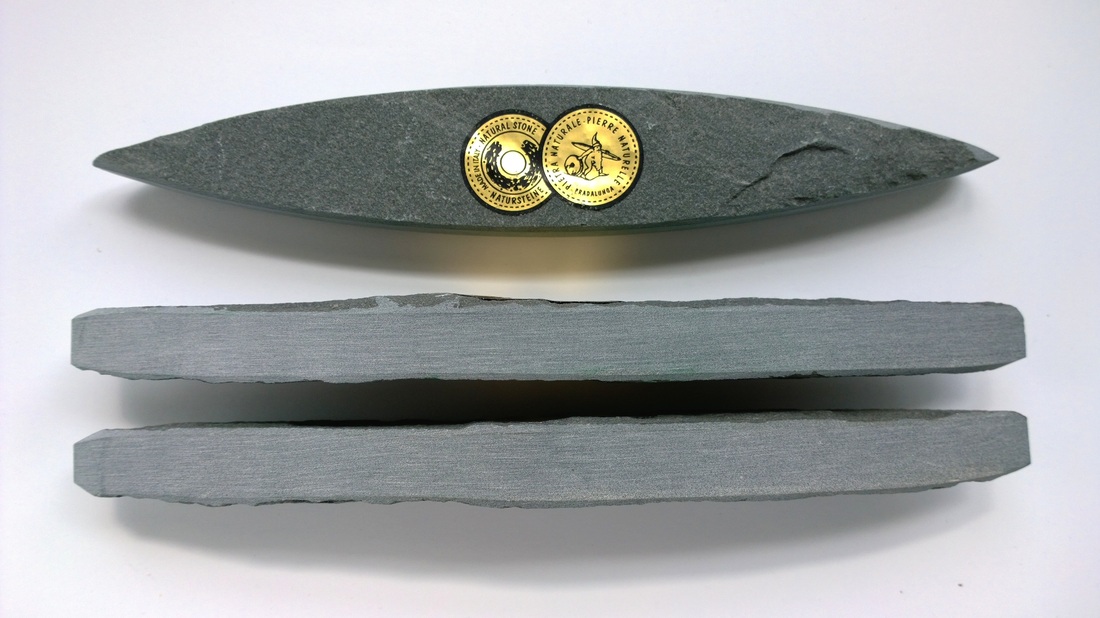Check it. For mirror polish. Lol.








Did that Jasper come from a seller in Idaho?
Did that Jasper come from a seller in Idaho?
@cotedupy et al. do you know anything of these scythe stones? Bergamasca, Bregenzer, Bergamo, Doppelbock/Pradalunga




Get out of my head!If you haven't already, might ask Benjamin of ByxCo.
How does everyone feel about me adding "Welsh Slates" verbatim to the chart?
- Welsh Slates (Yellow Lake Oilstone, Glanrafon, Nantlle Valley &c.) 6k - 14k
Another vote for a Soft Ark if one is purely looking for a mid-grit natural, though with some caveats...
They're sort of in a 1.5-3K ish sort of range, depending upon how they're lapped, how burnished they are, etc. Like all Arks, the edges off of them are very 'crisp' compared to synthetics, or even some other naturals.
... Jumping from an SG500 to either a soft Ark, or a BBW/Coti on mud is typically a bit much, if you're looking at this sort of progression. 800-1K, sure. 500-600, that's pretty cuspy unless you've got a crazy-fast Coti on full mud.
If I am not just talking to myself now I could use some input regarding this excerpt:
This is a significantly finer estimate for the Soft Arkansas stone than provided by @stringer @captaincaed and @cotedupy
If you wanted to remove all bevel scratches what kind of synthetic stone would fit in a progression right before a typical Soft Arkansas?
Indeed, I am trying to include that range as best I can figure and then represent it in a reasonable way.The biggest issues I see with trying to categorize the grit ratings of something like a soft Ark are 1) some natural variation, 2) pressure can play a fairly big role, 3) the specific knife being sharpened (steel, state of the edge, etc.).

Agreed.When trying to rate to rate natural stones in comparison to JIS or Cami or whatever there are actually are two factors that we are considering: The speed of the stone, which might be broadly analogous to the low end of its grit range estimate. And the finishing level of the stone, at the high end of the grit range estimate.
Eloquently stated.Synthetic whetstones (and other abrasives) don't really have this range and dichotomy to anything like the same degree. Because thy are very specifically designed to continue to abrade in the same manner, releasing particles of a uniform size, and constantly exposing fresh abrasive. Until they have no abrasive left and you replace them. Natural whetstones on the other hand are not very specifically designed to abrade in the same manner, releasing particles of a uniform size, and constantly exposing fresh abrasive.
Amen.Natural whetstones get used and experienced in different ways by different people, and they get called different names by different people. Because we're trying to compare things that are man-made and tightly defined and deliberately unvarying, to things that exist on spectrums and are ineffably plural and variable.
My gosh! Did I just read the script for Gettysburg?
1.) The Scandinavian stones you're thinking of including are extremely niche. The only reason anyone's really heard of them is because of G&H, but if you did a poll of all the members here and on Badger & Blade, you'd find no more than a handful of people who own even one of them.
British stones such as Charnleys, Idwals, Tams, Dalmores, WoA, Yellow Lakes &c. are far more common, and are found all over the world. ...
Alright, so what name do I use and what range do I give it? I believe I recall reading that "Belgian Blue Whetstone" is a more recent concoction. If this is "six of one and half a dozen of the other" I'll probably pick "La Lorraine" as it's the most concise without using abbreviations and I like the vintage label.3.) The difference between Rouge du Salm, La Lorriane, and Belgian Blue Whetstone, is at best contentious. And historically the names got applied differently by different mines/quarries.
Dalmore stones are good if you can find a soft/soft medium example which is not soaked in oil. I have had hard examples that would not cut until slurried, and very pretty swirled ones that self slurry like a jnat.I already have Tam O'Shanter, Water of Ayr, and Dalmore Blue on my list.
I need this kind of feedback as I have little exposure to the world of natural whetstones. Nevertheless there are reasons for the initial selection I made that I want to explain.
I can only commit so much space to natural whetstones within the GLGC, the primary limitation in the form of the width of the column. Stones that overlap in grit range stack up, so I have to limit the number of these at any given level. There seem to be a lot more fine naturals than coarse ones, so I have to be quite selective in that area, whereas conversely I struggle to find enough coarse stones to fill out the chart. This lead me to the Orsa and Gotlands stones, then the Loos stone for a more complete family. The Loos stone overlaps others so I might drop it, but at the moment the Orsa and Gotlands are "free" in that there is nothing that could take their place.
I like the idea of having historic items on the chart so long as they do not come at the expense of more pertinent items. For example my charts lets someone reading an old woodworking book get some bearing on what "start with M2 glasspaper" means. Your remark about Norwegian Ragstone more makes me want to include it than the contrary, if it could be represented by a single item and not a whole family.
Given my space issue I asked earlier if it would be reasonable to include "Welsh Slates" verbatim as an item, as I cannot see making room for each of "Yellow Lake Oilstone, Glanrafon, Nantlle Valley" individually. I reiterate. Should I pick a single one if that's all I have room for? Which?
You footnoted Charnley Forest and Llyn Idwal with the disclaimer about the difficulty in quantifying dense novaculite. I included Arkansas stones because they are ubiquitous, but I thought perhaps it was better not to include these other novaculites because of that? (And of course there's still the crowding in fine grits problem.)
I already have Tam O'Shanter, Water of Ayr, and Dalmore Blue on my list.
4.) Cotis have been quarried pretty much continuously for at least 2,000 years, and from multiple mines.
I can't emphasize this enough: It's impossible to give a rating for a 'standard' Coticule, because such a thing doesn't exist. ...
... I think your suggestion of 1.5k - 8k as a core range for modern Yellow Coticule is as good it could be. ... But as I say - including a rating like that, in that way, would IMO be counter-productive.
5.) ... Moreover the definition of a Soft Ark is exceptionally blurry; historically there has been no real, delineated distinction between Soft Arks and Washitas. For instance there’s no mention of ‘Soft Arkansas’ stones in Griswold's 1890 geological survey, they appear to be an invention of Pike's around 1900, in part probably as a way of claiming they were the only company who had access to 'true' Washitas. And the stones that Pike and Norton sold as 'Soft Arkansas' are what most companies today would call 'Hard Arkansas'. While many of the stones sold today as 'Soft Arkansas’ are probably what Griswold would've called 'Calico Washitas'.
The specific gravity of stones that have been sold as Soft Arkansas or Washita can be anywhere from about 2.00 up to about 2.55. That range is huge. The only other type of whetstone I know with a comparable range of possible densities, and which we call by a single name are, you guessed it... Coticules.
6.) Regarding Cretan/Turkish Oilstones - changing my mind between 500-7k to 800-8k is really quite a small difference when trying to 'grit rate' natural stones vs JIS. In fact I'm amazed those ranges are so similar. I do have one or two old Turkish that can abrade at around 500, and one or two that would top out finishing at 10k or slightly above. For the purposes here I tried to condense the range down to what someone might expect if buying a modern Cretan stone, which might be something like 1k - 9k or 2k - 10k.
I would no longer stand by what I said a few years back about Turkish being faster than Washitas. They can be, depending on the two particular stones being compared, but in general I would now say that Washitas sit a little below Turkish.
When trying to rate natural stones in comparison to JIS or ANSI/CAMI or whatever there are actually are two factors that we are considering: The speed of the stone, which might be broadly analogous to the low end of its grit range estimate. And the finishing level of the stone, at the high end of the grit range estimate.
Synthetic whetstones (and other abrasives) don't really have this range or dichotomy to anything like the same degree. Because they are very specifically designed to continue to abrade in the same manner, releasing particles of a uniform size, and constantly exposing fresh abrasive. Until they have no abrasive left, and you replace them.
Enter your email address to join: